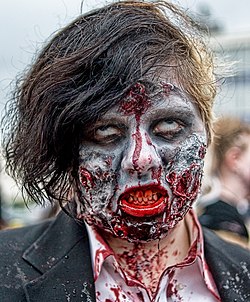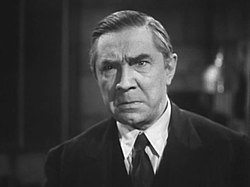
Selected horror profile
Béla Lugosi (20 October 1882 – 16 August 1956) was a Hungarian actor of stage and screen, well known for playing Count Dracula in the Broadway play and subsequent film version. In the last years of his career he featured in several of Ed Wood's low budget films.
Through his association with Dracula (in which he appeared with minimal makeup, using his natural, heavily accented voice), Lugosi found himself typecast as a horror villain in such movies as Murders in the Rue Morgue, The Raven, and Son of Frankenstein for Universal, and the independent White Zombie. His accent, while a part of his image, limited the roles he could play. Lugosi did attempt to break type by auditioning for other roles. He lost out to Lionel Barrymore for the role of Rasputin in Rasputin and the Empress; C. Henry Gordon for the role of Surat Khan in Charge of the Light Brigade; Basil Rathbone for the role of Commissar Dimitri Gorotchenko in Tovarich (a role Lugosi had played on stage). It is an erroneous popular belief that Lugosi declined the offer to appear in Frankenstein. Lugosi may not have been happy with the onerous makeup job and lack of dialogue, but was still willing to play the part. Nonetheless, James Whale, the film's director, replaced Lugosi and would do this again in Bride of Frankenstein (Lugosi was supposed to play the role of Dr. Pretorius). Selected horror work
"The Raven" is a narrative poem by American writer and poet Edgar Allan Poe first published in January 1845. Noted for its musicality, stylized language and supernatural atmosphere, it tells of a talking raven's mysterious visit to a distraught lover, tracing his slow descent into madness. The lover, often identified as a student, is lamenting the loss of his love, Lenore. The raven, sitting on a bust of Pallas, seems to further instigate his distress with its repeated word, "Nevermore." Throughout, Poe makes allusions to folklore and various classical works. Poe claimed to have written the poem very logically and methodically. His intention was to create a poem that would appeal to both critical and popular tastes, as he explains in a follow-up essay, "The Philosophy of Composition". The poem was inspired in part by a talking raven in the novel Barnaby Rudge: A Tale of the Riots of 'Eighty by Charles Dickens. The first publication of "The Raven" on January 29, 1845 in the New York Evening Mirror made Poe widely popular in his day. The poem was soon heavily reprinted, parodied, and illustrated. Though some critics disagree about the value of the poem, it remains one of the most famous poems ever written.
Horror topics
|
© MMXXIII Rich X Search. We shall prevail. All rights reserved. Rich X Search



